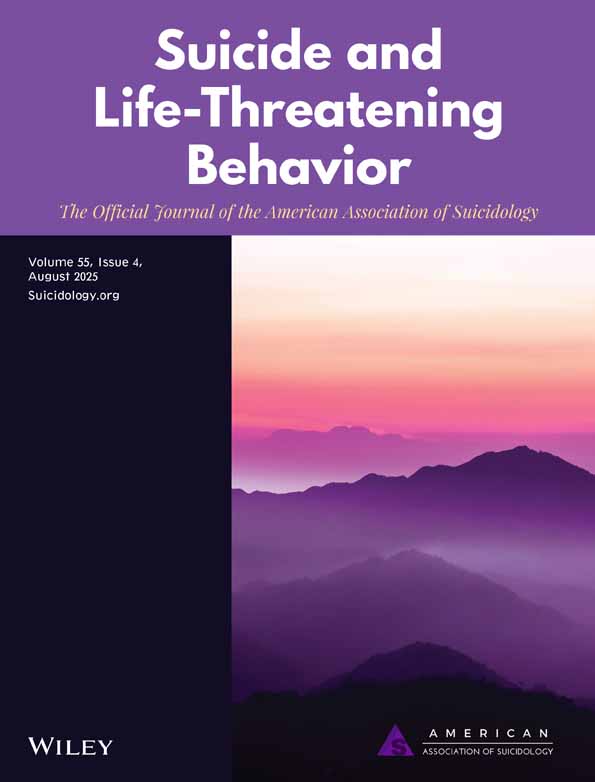Generational Analyses of Suicide: Baby Boomers and 13ers
This manuscript is a revised version of the 1994 AAS Presidential Address delivered April 7 in New York City at the annual meeting of the American Association of Suicidology.
Primary funding to obtain the annual mortality data tapes used here was obtained from grants from the Retirement Research Foundation, Park Ridge, IL. Funds for additional years were received from Grants-in-Aid from Indiana University South Bend and Vice Chancellor Lester Lamon. Data tapes for 1987–1991 were obtained through the Inter-University Consortium for Political and Social Research (ICPSR) at the Institute for Social Research at the University of Michigan.
Abstract
“Generational analysis” is proposed that would consider actual cohort or generational suicide risk. Personality characteristics of different generations are discussed as they may affect suicide, its prevention, and intervention. In addition, annual suicide data for 1968–1991 are presented for the “Boom” generation (born 1943–1960) and for the young group of Americans called 13ers (the 13th generation of Americans; born 1961–1981). Results indicate that Boomers are presently 1 of every 3 suicides and 1 of every 4 Americans, while 13ers are 1 of 4 suicides and 1 of 3 in the population. Consistent with previous cohort analysis studies, these two cohorts are at greater risk than earlier generations at the same chronological age, with 13ers higher than Boomers for the ages they have thus far attained. It is recommended that researchers, theorists, and mental health professionals consider generational issues, and that suicidology expand its attention to the life cycles of generations.
As a developmental psychologist as well as a suicidologist, I read and listened with great interest to the many cohort analyses of suicide rates that were conducted and reported through the 1980s for the United States and other countries (Goldney & Katsikitis, 1983; La Vecchia, Bollini, Imazio, & Decarli, 1986; Lester, 1984, 1988; Lindesay, 1989, 1991; Manton, Blazer, & Woodbury, 1987; Moens, Van Oortmarssen, Honggokoesoemo, & Van de Voorde, 1987; Murphy & Wetzel, 1980; Nordstrom, & Asgard, 1986; Reed, Camus, & Last, 1985; Skegg & Cox, 1991; Solomon & Hellon, 1980; Solomon & Murphy, 1984; Surtees & Duffy, 1989; Wasserman, 1987, 1989). These studies utilized a loose definition of the concept of “cohort.” They were not actually contemplating the suicide rates of cohorts as defined by developmental psychology. Similar to the data of Figure 1, the studies were instead looking at 5- or 10-year age group suicide data across time to follow the progression of these 5- or 10-year “cohorts” as they became older. These groups may more properly be classified as “convenience cohorts” in the same fashion as research performed on available subjects is said to utilize convenience samples.
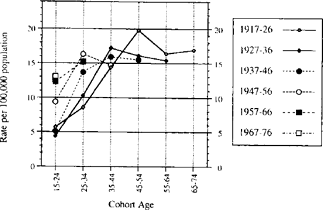
Cohort analysis of U.S. suicide rates by 10-year age groups, 1941–1991.
At the time these investigations were conducted, in the United States at least, essentially the only data available were the annually published suicide figures from the National Center for Health Statistics (NCHS) in volumes of Vital Statistics of the United States. The aggregate nature of these 5- and 10-year age group data prevented true annual cohort analyses. Despite these limitations, the results of the studies (and as shown in Fig. 1) implied that successive cohorts within a nation are generally at higher risk than their predecessors for suicide as they attain each successively older age.
In order to fully understand the new form of true cohort analyses being proposed and the conceptual limitations of earlier studies, it is necessary to precisely define the term cohort. Developmental psychologists and others refer to a birth cohort as all those individuals born about the same point in time. In addition to time of birth, which usually involves a number of birth years, cohort members also experience a set of historical and social events in their culture and world. The experience of these events differs among the various birth cohorts in a population at any point in time.
For example, the invention and proliferation of something like computers has been experienced differently by the cohort groups of the population. The elders among us may exhibit computer phobia or unfamiliarity, making little attempt to learn or become familiar with computers. Those born since World War II, who are in their 30s and 40s, probably represent a mix of exposure to computers, with many individuals using computers to one degree or another in their lives and work, once they became knowledgeable about them. The young, on the other hand, our teens and those in their 20s, have grown along with computers, never living in a world without them in one form or another, from Nintendo and Sega, to hand-held Game boys, to IBMs and Apple Macintosh computers in school, and so forth. Computers mean different things to these groups even though they all experienced them at the same time. The age, background, and other factors affected how the groups responded and how they will continue to respond to and think about computers. So it is with nearly all major cultural and historical events.
William Strauss and Neil Howe, in their 1991 book Generations, define the term generation as “a special cohort-group whose length approximately matches that of a basic phase of life” (p. 34). They labeled these life phases as youth, rising adulthood, midlife, and older adulthood. Therefore, Strauss and Howe utilize the term generation in a manner similar to the use of cohort as defined above but encompassing a larger range of years (they suggest approximately 21 years). Since the suicide literature already includes a technique called cohort analysis, and I am proposing here a different but related perspective in considering suicide data, it is suggested that a better term for the analyses approach here would be generational analyses of suicide.
An additional aspect of cohorts or generations is that, as a result of their experiences and the timing of their births, they have somewhat different “personalities.” Strauss and Howe (1991) refer to this as “peer personality,” defined as “a set of collective behavioral traits and attitudes that later expresses itself throughout a generation's lifecycle trajectory” (p. 32). Generational persona are derived from: “(1) common age location; (2) common beliefs and behavior; and (3) perceived membership in a common generation” (p. 64). The generational personality of two cohorts will be noted later along with the implications for possible suicide prevention throughout their generational life cycles.
Presently, and at any time, in our population there are essentially four major birth cohorts, with the last of a fifth dying out and a sixth born in recent and upcoming years. Strauss and Howe reported their conceptualization of and traced the cycle of generations in the United States, including the four major generations of present-day Americans. The old among us they have called the “GI” elders who were born between the years 1901 and 1924. The “Silent” midlifers of our society were born from 1925 to 1942. Then comes the cohort with which we are all familiar, the “Boom” generation who in 1991 were “rising adults,” born from 1943 to 1960. Finally, they identified the presently youthful group born in the years 1961 to 1981 following the Boomers as “13th” because they were determined to be the 13th generation of Americans. (The dying out “Lost” generation born from 1883 to 1900, and those who have or will be born from 1982 to the year 2003, called “Millennial,” are also noted).
This presentation focuses only on the Baby Boomers and the 13ers. Even here the analyses are preliminary and a consideration of older cohorts is also underway (Payne, Kastenbaum, & Mcintosh, 1994). In 1994 the 13ers are 13–33 years of age while the Boomers are 34–51. In 1991 the cohort of Americans referred to as Baby Boomers because of their large numbers were 31–48 years old, and represented 68.3 million of the 252.2 million American population, or 27.1% of the national population (U.S. Bureau of Census, 1993). The personality of Boomers has been characterized as an idealistic generation with great expectations who were indulged as children. Their experiences produced people who were individualistic (Russell, 1993, prefers the term “free agents”), optimistic, and pampered, for whom the American Dream was attainable. As Strauss and Howe (1991, p. 307) report, “Asked to compare themselves economically with their fathers at the same phase of life, Boomers are evenly split over whether they are doing better or worse. Yet they overwhelmingly consider their careers better … their personal freedoms greater … and their lives more meaningful.”
The generation that follows the Boomers has been given various names, including After Boomers, Generation X, Baby Busters, Slackers, and as noted here, 13ers. They are actually a larger cohort than the Boomers, representing almost 79.3 million Americans or 31.4% of the population in 1991 (U.S. Bureau of Census, 1993) and in that year were 10–30 years old. Compared to Boomers, descriptions of the 13er personality most often include pessimism regarding whether their standard of living will be as good as their parents as well as their future in general. Disapproval and even resentment of Boomers is also frequently noted (tension between the generations as always). Their personality characteristics have been described in such terms as skeptical, cynical, alienated, practical, and self-reliant children of divorce (and/or busy working parents) for whom the American Dream seems remote. They have lived with high divorce rates, huge national debt, government scandals, AIDS, etc., in a tougher, more punishing world (see e.g., Howe & Strauss, 1993).
This introduction brings me to the reason for this consideration. Presidential addresses provide an opportunity to speculate and ponder different questions. Therefore, I want to derive a preliminary idea regarding suicide in Boomers and 13ers. What is the suicide risk of these two cohorts who combined represent 6 of every 10 Americans, who will for decades have a major influence on our society and its future? Finally, I will briefly speculate regarding possible preliminary implications for suicide prevention from this study of birth cohorts.
DATA METHOD AND RESULTS
Utilizing Strauss and Howe's (1991) definition of cohort birth years noted above, the birth cohort of each individual whose death was classified as suicide in the United States from 1968 to 1991 was determined from computerized data tapes for each individual year. These tapes are prepared by the National Center for Health Statistics and list each individual death separately, including a large number of demographic variables. Cohort membership for each individual was determined by subtracting the age at death from the year of death to derive a birth year, because the year of birth is not available. (This calculation method will have a small error for cohort membership for those individuals born in the first or last years of a cohort and for whom the timing of their death compared to their birthday may lead to a misclassification.) Only the Boomer and 13er birth cohorts were studied in detail.
Suicide rates were calculated for each cohort and for gender by combining the suicide data for each year and annual population estimates by single years of age (U.S. Bureau of Census, 1974, 1982, 1993). Earlier suicide data were also utilized to provide some comparisons prior to 1968 (NCHS, annual volumes).
It is important to realize that whenever we look at suicide data by age, we are observing cohort data simultaneously; they are simply disguised and the element of cohort is de-emphasized. Although rather imprecisely, we can indicate where cohorts are present. For example, Figure 2 displays the rates of suicides by traditionally studied age groups in 1991. If the numbers of suicides are displayed instead by single years of age, as can be determined from the data tapes, we show age differences and with only minor effort we can highlight the contribution of each cohort as well (Fig. 3). Grouping by cohort/generation rather than traditional age groupings reveals that suicide rates are generally higher among older age groups and within cohort groups as the cohort ages across time (see Fig. 4).

U.S. suicide rates by age groups and birth cohorts, 1991.
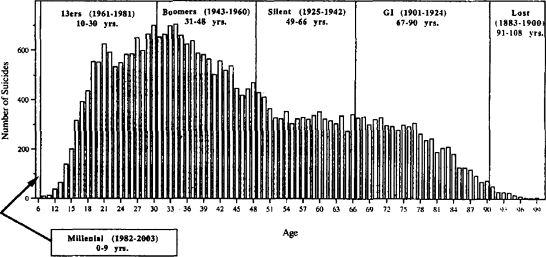
U.S. suicides by single years of age and birth cohorts, 1991.
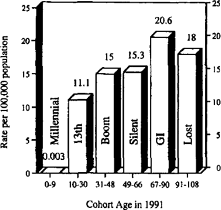
U.S. suicide rates by birth cohort, 1991.
From this overall perspective on cohorts within the data we normally see, I would like to briefly present the data derived for Boomers and 13ers from 1968 to 1991. These two cohorts have a large influence on suicides and the population. Proportions of 1991 suicides and population for each reveal that Boomers are 1 of every 3 suicides (10,270 of 30,810) and 1 of every 4 Americans. The 13ers are 1 of every 4 suicides (8,804) and 1 of every 3 in the population. Combined, the two groups contributed 6 of every 10 suicides in 1991 (19,074).
As can be seen in Figure 5, both cohorts have shown increases in suicide rates as its members have aged (observe that the rates for 13ers are lower at any point in time because they are younger). It should be noted that in the calculation of rates, only the population of the cohort for which suicide can be classified is utilized (i.e., those aged 5 years and above). Figure 5 also shows that traditional sex differences have been observed for both groups. That is, males at all ages have considerably higher rates within both cohorts.

Suicide rates among Baby Boom and 13er birth cohorts by sex, 1968–1991.
Our attention was originally directed toward Boomers' suicide risk while they comprised the young population between the ages of 15 and 24. Figure 6 indicates the years in which young people 15–24 years old were exclusively members of a single generation and where there were transition periods representing two cohorts. As can be clearly seen, the dramatic increases in suicide rates for those aged 15–24 were almost completely observed during the time period when Boomers were most or all of those of this age grouping. Interestingly, 13ers have not evidenced continued increases in rates, but at the same time no decrease in rates has been seen as the change of cohorts comprising this age grouping has taken place.

U.S. suicide rates for 15- to 24-year-olds by birth cohort contribution, 1933–1991.
As noted earlier, previous cohort analysis studies suggested that successive cohorts displayed higher suicide rates than earlier generations at the same chronological age. Evidence for the same phenomenon was found here for Boomers and 13ers (see Fig. 7). Although there are exceptions for the GI and Silent generations (which might be explained by the time periods at which these cohorts were of particular ages, i.e., World War II, the 1950s), Boomers and 13ers had higher suicide rates at each age period they have thus far attained when compared to previous cohorts that are alive today. In addition, for the two age periods for which data are thus far available, 13ers show higher risk than Boomers. (It is important to remember the cohorts are different and the time period at which the cohort is at that particular age also differs. Rate differences not only reflect cohort differences but are necessarily confounded with historical time.) These data reflect the first year in which the age groups displayed (i.e., 5–19, 10–24, etc.) are entirely comprised of the particular generation. Because the number of birth years represented by each cohort varies, the largest possible age interval that can be considered to roughly represent the full generation is 15 years (previously published figures are available only for 5-year age groups).
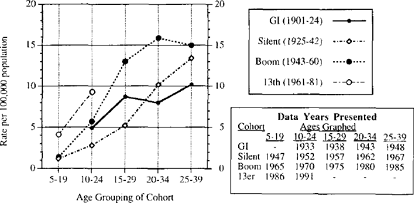
Generational analysis of U.S. suicide rates for 15-year age groupings, 1933–1991.
DISCUSSION AND CONCLUSIONS
Generational analysis has considerable promise for understanding suicide risk among individuals of various ages and particularly the additional impact of cohort membership and experiences. Earlier considerations of cohort differences in suicide have typically hypothesized variables other than cohort experiences or generational persona to explain observed patterns. Most often the issue of cohort size (i.e., the number of members) relative to other cohorts has been emphasized (e.g., Ahlburg & Schapiro, 1984; Holinger & Offer, 1982; Pollinger-Haas & Hendin, 1983). The Easterlin (1980) hypothesis suggests that large cohorts produce increased competition and stress among the cohort members and will be associated with high suicide rates as well. This population model (see also Holinger, Offer, Barter, & Bell, 1994: pp. 75–85) predicts continued high suicide rates as a large cohort ages. The present data provide some evidence for this hypothesis in the high rates for the large Boomer cohort and the even higher rates for the still larger 13er generation. However, if this hypothesis is true, can anything be done to prevent the suicides of Boomers and 13ers? I am less pessimistic and fatalistic (remember, I am a Boomer). Models based solely on population size ignore the concept of generational personality and how this differs among cohorts. I contend that these personalities and perspectives are carried with a cohort and even altered with the passage of time. Further, the period of life in which cohort members find themselves and events that occur as the cohort members live their lives have great potential for influencing future rates of suicide (see also Mcintosh, 1992). In addition, these various cohort differences may have implications for suicide prevention and intervention.
Based on their experiences and personalities, a mixed picture of risk as well as protection from suicide-producing forces exists presently for these two cohorts. Boomers have experienced favorable employment circumstances, are favorably inclined toward mental health, and have largely achieved their life goals and exceeded the economic achievements of their parents. It can be argued that each of these factors may produce better mental health, utilization of services, and fewer suicides. However, the high rates of depression frequently noted among Boomers (e.g., Klerman, 1989; Klerman & Weissman, 1989; Lewinsohn, Rohde, Seeley, & Fischer, 1993) are potentially important for future risk, as is the large size of the cohort and the stress and vulnerability noted above that are associated with it.
A similar, mixed picture of risk emerges for 13ers. They may not attain the economic or occupational levels of their parents, lessening present and future resources. They may evidence a more pessimistic and fatalistic viewpoint toward life. These characteristics and circumstances may lead to higher levels of suicide throughout their lifetime. In addition, the same potentially negative aspects associated with their very large cohort size may produce high suicide rates. The resentment of Boomers has already been noted and this might increase if 13ers perceive them as “hanging on” to the available jobs during midlife and into old age, along with the possible depletion of societal resources as they reach older adulthood.
Despite this catalog of potential negative factors, it is also conceivable that 13ers may have learned effective coping mechanisms to deal with potential life problems as a result of their experiences in adapting to divorce, both parents working, and a tougher world. If true, it can be argued that unlike the “pampered” Boomers who may have less often been forced to confront adversity, that 13ers' coping skills and ability to mobilize resources may serve them well as they age. Strauss and Howe (1991: p. 334) highlight this aspect, noting that “this streetwise generation does indeed bring a bag of savvy tricks their elders lack-skills that may come in handy the next time America gets into real trouble. More than anyone, they have developed a seasoned talent for getting the most out of a bad hand.” Therefore, although problems may exist, the psychological pain and hopelessness necessary for suicide may be lessened (see Shneidman, 1985, 1993) as 13ers grow older.
I believe we can begin to intervene and to combat these possible tendencies toward suicide among Boomers and 13ers, and build on their strengths. These efforts can start with increased awareness of generational differences by counselors and crisis intervention workers, and the utilization of this knowledge in intervention measures. If the age of the caller or client matters, it follows that their cohort membership is potentially important as well among the variables weighed in risk assessment and intervention measures taken. Awareness of generational differences may also have implications for how services are advertised. As is apparent in marketing and advertising campaigns, this may mean altering our approach to gain the attention and raise the awareness of the varying cohorts.
Concerted research efforts are needed to determine what effect these cohort groups will have on the nature of the world and the periods of their future life cycle and how (or if) this will affect the likelihood of suicide. Studies are also needed of the various cohorts to determine what approaches might increase the likelihood that they will seek help, and how to prevent suicide and intervene in therapy. Effective therapy requires knowledge of how the individual views himself or herself and the world; cohort experiences are part of this picture. This has not been a major aspect of therapy and intervention in the past. Efficacy studies may determine that generational issues are not large enough to require major alterations, but this can only result from appropriate research. It is time to open a dialogue that encourages researchers, theorists, and mental health professionals to ponder and consider generational issues among the others they contemplate. Cohort peer personality and experiences might be considered along with individual history and “careers” (e.g., Maris, 1981).
Additional research is also needed to statistically determine and separate the individual and combined effects of age, cohort, and period. Continuing epidemiological studies are needed to monitor whether generational rates continue to be higher among Boomers and 13ers as they move through adulthood to middle age and older adulthood. It is possible that present rates will instead follow the long-term national trends of decreases in rates among those over age 40 (e.g., Mcintosh, Santos, Hubbard, & Overholser, 1994: Chap. 1). It is also likely that differences within these cohorts exist (e.g., Boomers born in the 1940s vs. those born in the mid- to late-1950s — Gibson, 1993).
There are many issues to consider and arguments to carefully study them. The number of researchers who are themselves Boomers and now 13ers is becoming increasingly larger, Boomers are the parents of 13ers. Therefore the issues are personally relevant as well. The number of individuals in these cohorts will continue to be large. They are now 6 of 10 Americans, but even in the year 2030, when they will be aged 49–87, they will still comprise 4 of every 10 in the United States population (U.S. Bureau of the Census, 1989). It is unclear which “attributes” in each generational persona will influence their suicide risk in the future. I believe it is certain that more than simply personality will have an impact, including events, resources, planning, and so forth. In this regard, suicidology should expand its attention from an emphasis on life periods in isolation, such as youth and elderly suicide, to larger perspectives on suicidal behavior among groups and individuals moving simultaneously through time and life cycles.



